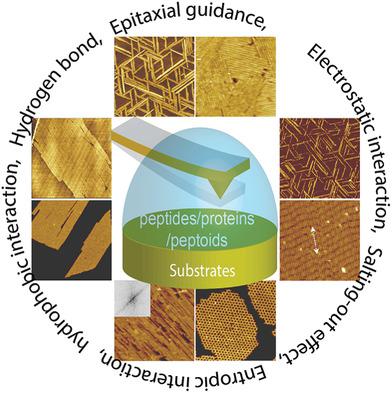当前位置:
X-MOL 学术
›
Adv. Mater.
›
论文详情
Our official English website, www.x-mol.net, welcomes your feedback! (Note: you will need to create a separate account there.)
Engineering Biomolecular Self-Assembly at Solid–Liquid Interfaces
Advanced Materials ( IF 29.4 ) Pub Date : 2020-07-06 , DOI: 10.1002/adma.201905784 Shuai Zhang 1, 2 , Jiajun Chen 1, 2 , Jianli Liu 2, 3 , Harley Pyles 4, 5 , David Baker 4, 5, 6 , Chun-Long Chen 2, 7 , James J De Yoreo 1, 2
Advanced Materials ( IF 29.4 ) Pub Date : 2020-07-06 , DOI: 10.1002/adma.201905784 Shuai Zhang 1, 2 , Jiajun Chen 1, 2 , Jianli Liu 2, 3 , Harley Pyles 4, 5 , David Baker 4, 5, 6 , Chun-Long Chen 2, 7 , James J De Yoreo 1, 2
Affiliation

|
Biomolecular self-assembly is a key process used by life to build functional materials from the “bottom up.” In the last few decades, bioengineering and bionanotechnology have borrowed this strategy to design and synthesize numerous biomolecular and hybrid materials with diverse architectures and properties. However, engineering biomolecular self-assembly at solid–liquid interfaces into predesigned architectures lags the progress made in bulk solution both in practice and theory. Here, recent achievements in programming self-assembly of peptides, proteins, and peptoids at solid–liquid interfaces are summarized and corresponding applications are described. Recent advances in the physical understandings of self-assembly pathways obtained using in situ atomic force microscopy are also discussed. These advances will lead to novel strategies for designing biomaterials organized at and interfaced with inorganic surfaces.
中文翻译:

在固液界面进行工程生物分子自组装
生物分子自组装是生命从“自下而上”构建功能材料的关键过程。在过去的几十年里,生物工程和生物纳米技术借用这种策略来设计和合成众多具有不同结构和特性的生物分子和混合材料。然而,将固-液界面处的生物分子自组装工程化为预先设计的架构在实践和理论上都落后于批量解决方案取得的进展。在这里,总结了在固液界面进行肽、蛋白质和类肽的编程自组装的最新成果,并描述了相应的应用。还讨论了使用原位原子力显微镜获得的自组装途径的物理理解的最新进展。
更新日期:2020-07-06
中文翻译:

在固液界面进行工程生物分子自组装
生物分子自组装是生命从“自下而上”构建功能材料的关键过程。在过去的几十年里,生物工程和生物纳米技术借用这种策略来设计和合成众多具有不同结构和特性的生物分子和混合材料。然而,将固-液界面处的生物分子自组装工程化为预先设计的架构在实践和理论上都落后于批量解决方案取得的进展。在这里,总结了在固液界面进行肽、蛋白质和类肽的编程自组装的最新成果,并描述了相应的应用。还讨论了使用原位原子力显微镜获得的自组装途径的物理理解的最新进展。


























 京公网安备 11010802027423号
京公网安备 11010802027423号